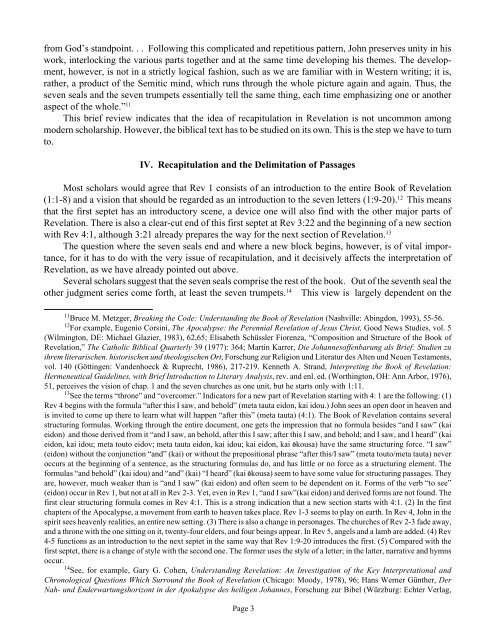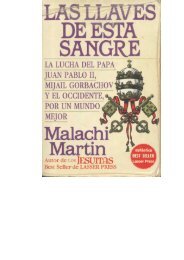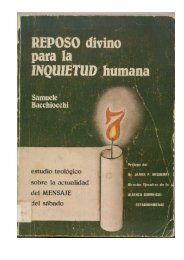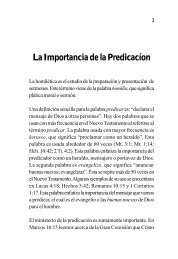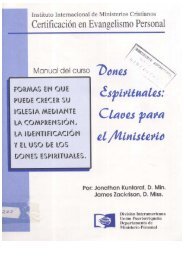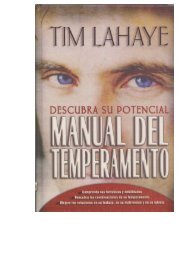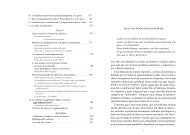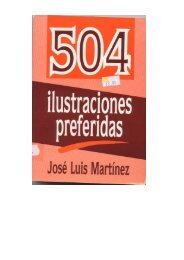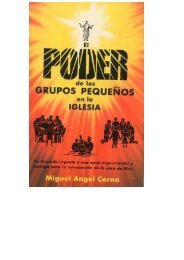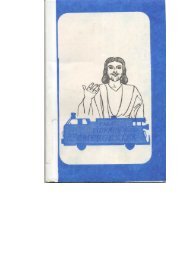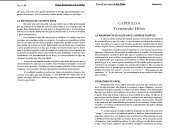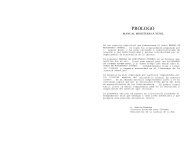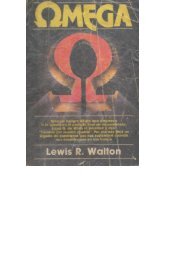Recapitulation in Revelation 4-11 - Ptr. Arturo Quintero
Recapitulation in Revelation 4-11 - Ptr. Arturo Quintero
Recapitulation in Revelation 4-11 - Ptr. Arturo Quintero
- No tags were found...
You also want an ePaper? Increase the reach of your titles
YUMPU automatically turns print PDFs into web optimized ePapers that Google loves.
from God’s standpo<strong>in</strong>t. . . Follow<strong>in</strong>g this complicated and repetitious pattern, John preserves unity <strong>in</strong> hiswork, <strong>in</strong>terlock<strong>in</strong>g the various parts together and at the same time develop<strong>in</strong>g his themes. The development,however, is not <strong>in</strong> a strictly logical fashion, such as we are familiar with <strong>in</strong> Western writ<strong>in</strong>g; it is,rather, a product of the Semitic m<strong>in</strong>d, which runs through the whole picture aga<strong>in</strong> and aga<strong>in</strong>. Thus, theseven seals and the seven trumpets essentially tell the same th<strong>in</strong>g, each time emphasiz<strong>in</strong>g one or anotheraspect of the whole.” <strong>11</strong>This brief review <strong>in</strong>dicates that the idea of recapitulation <strong>in</strong> <strong>Revelation</strong> is not uncommon amongmodern scholarship. However, the biblical text has to be studied on its own. This is the step we have to turnto.IV. <strong>Recapitulation</strong> and the Delimitation of PassagesMost scholars would agree that Rev 1 consists of an <strong>in</strong>troduction to the entire Book of <strong>Revelation</strong>(1:1-8) and a vision that should be regarded as an <strong>in</strong>troduction to the seven letters (1:9-20). 12 This meansthat the first septet has an <strong>in</strong>troductory scene, a device one will also f<strong>in</strong>d with the other major parts of<strong>Revelation</strong>. There is also a clear-cut end of this first septet at Rev 3:22 and the beg<strong>in</strong>n<strong>in</strong>g of a new sectionwith Rev 4:1, although 3:21 already prepares the way for the next section of <strong>Revelation</strong>. 13The question where the seven seals end and where a new block beg<strong>in</strong>s, however, is of vital importance,for it has to do with the very issue of recapitulation, and it decisively affects the <strong>in</strong>terpretation of<strong>Revelation</strong>, as we have already po<strong>in</strong>ted out above.Several scholars suggest that the seven seals comprise the rest of the book. Out of the seventh seal theother judgment series come forth, at least the seven trumpets. 14 This view is largely dependent on the<strong>11</strong> Bruce M. Metzger, Break<strong>in</strong>g the Code: Understand<strong>in</strong>g the Book of <strong>Revelation</strong> (Nashville: Ab<strong>in</strong>gdon, 1993), 55-56.12 For example, Eugenio Cors<strong>in</strong>i, The Apocalypse: the Perennial <strong>Revelation</strong> of Jesus Christ, Good News Studies, vol. 5(Wilm<strong>in</strong>gton, DE: Michael Glazier, 1983), 62,65; Elisabeth Schüssler Fiorenza, “Composition and Structure of the Book of<strong>Revelation</strong>,” The Catholic Biblical Quarterly 39 (1977): 364; Mart<strong>in</strong> Karrer, Die Johannesoffenbarung als Brief: Studien zuihrem literarischen. historischen und theologischen Ort, Forschung zur Religion und Literatur des Alten und Neuen Testaments,vol. 140 (Gött<strong>in</strong>gen: Vandenhoeck & Ruprecht, 1986), 217-219. Kenneth A. Strand, Interpret<strong>in</strong>g the Book of <strong>Revelation</strong>:Hermeneutical Guidel<strong>in</strong>es, with Brief Introduction to Literary Analysis, rev. and enl. ed. (Worth<strong>in</strong>gton, OH: Ann Arbor, 1976),51, perceives the vision of chap. 1 and the seven churches as one unit, but he starts only with 1:<strong>11</strong>.13 See the terms “throne” and “overcomer.” Indicators for a new part of <strong>Revelation</strong> start<strong>in</strong>g with 4: 1 are the follow<strong>in</strong>g: (1)Rev 4 beg<strong>in</strong>s with the formula “after this I saw, and behold” (meta tauta eidon, kai idou.) John sees an open door <strong>in</strong> heaven andis <strong>in</strong>vited to come up there to learn what will happen “after this” (meta tauta) (4:1). The Book of <strong>Revelation</strong> conta<strong>in</strong>s severalstructur<strong>in</strong>g formulas. Work<strong>in</strong>g through the entire document, one gets the impression that no formula besides “and I saw” (kaieidon) and those derived from it “and I saw, an behold, after this I saw; after this I saw, and behold; and I saw, and I heard” (kaieidon, kai idou; meta touto eidov; meta tauta eidon, kai idou; kai eidon, kai ‘kousa) have the same structur<strong>in</strong>g force. “I saw”(eidon) without the conjunction “and” (kai) or without the prepositional phrase “after this/I saw” (meta touto/meta tauta) neveroccurs at the beg<strong>in</strong>n<strong>in</strong>g of a sentence, as the structur<strong>in</strong>g formulas do, and has little or no force as a structur<strong>in</strong>g element. Theformulas “and behold” (kai idou) and “and” (kai) “I heard” (kai ‘kousa) seem to have some value for structur<strong>in</strong>g passages. Theyare, however, much weaker than is “and I saw” (kai eidon) and often seem to be dependent on it. Forms of the verb “to see”(eidon) occur <strong>in</strong> Rev 1, but not at all <strong>in</strong> Rev 2-3. Yet, even <strong>in</strong> Rev 1, “and I saw”(kai eidon) and derived forms are not found. Thefirst clear structur<strong>in</strong>g formula comes <strong>in</strong> Rev 4:1. This is a strong <strong>in</strong>dication that a new section starts with 4:1. (2) In the firstchapters of the Apocalypse, a movement from earth to heaven takes place. Rev 1-3 seems to play on earth. In Rev 4, John <strong>in</strong> thespirit sees heavenly realities, an entire new sett<strong>in</strong>g. (3) There is also a change <strong>in</strong> personages. The churches of Rev 2-3 fade away,and a throne with the one sitt<strong>in</strong>g on it, twenty-four elders, and four be<strong>in</strong>gs appear. In Rev 5, angels and a lamb are added. (4) Rev4-5 functions as an <strong>in</strong>troduction to the next septet <strong>in</strong> the same way that Rev 1:9-20 <strong>in</strong>troduces the first. (5) Compared with thefirst septet, there is a change of style with the second one. The former uses the style of a letter; <strong>in</strong> the latter, narrative and hymnsoccur.14 See, for example, Gary G. Cohen, Understand<strong>in</strong>g <strong>Revelation</strong>: An Investigation of the Key Interpretational andChronological Questions Which Surround the Book of <strong>Revelation</strong> (Chicago: Moody, 1978), 96; Hans Werner Günther, DerNah- und Enderwartungshorizont <strong>in</strong> der Apokalypse des heiligen Johannes, Forschung zur Bibel (Würzburg: Echter Verlag,Page 3


